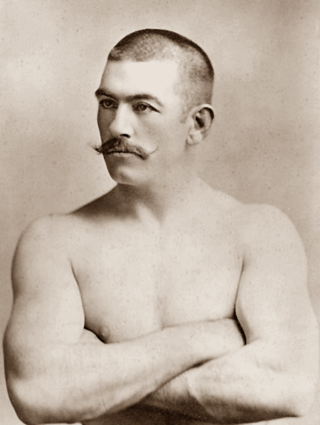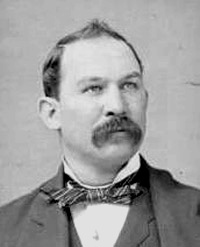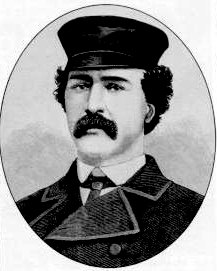
Robert James Fitzsimmons was a British professional boxer who was the sport's first three-division world champion. He also achieved fame for beating Gentleman Jim Corbett, and he is in The Guinness Book of World Records as the lightest heavyweight champion, weighing just 165 pounds when he won the title. Nicknamed Ruby Robert and The Freckled Wonder, he took pride in his lack of scars and appeared in the ring wearing heavy woollen underwear to conceal the disparity between his trunk and leg-development.

The Marquess of Queensberry Rules, also known as Queensbury Rules, are a code of generally accepted rules in the sport of boxing. Drafted in London in 1865 and published in 1867, they were named so as the 9th Marquess of Queensberry publicly endorsed the code, although they were written by a Welsh sportsman named John Graham Chambers from Llanelli, Carmarthenshire. The code of rules on which modern boxing is based, the Queensberry rules were the first to mandate the use of gloves in boxing.

Bare-knuckle boxing is a full-contact combat sport based on punching without any form of padding on the hands.

James Jackson Jeffries was an American professional boxer and World Heavyweight Champion.

John Lawrence Sullivan, known simply as John L. among his admirers, and dubbed the "Boston Strong Boy" by the press, was an American boxer recognized as the first heavyweight champion of gloved boxing, de facto reigning from February 7, 1882, to September 7, 1892. He is also generally recognized as the last heavyweight champion of bare-knuckle boxing under the London Prize Ring Rules, being a cultural icon of the late 19th century America, arguably the first boxing superstar and one of the world's highest-paid athletes of his era. Newspapers' coverage of his career, with the latest accounts of his championship fights often appearing in the headlines, and as cover stories, gave birth to sports journalism in the United States and set the pattern internationally for covering boxing events in media, and photodocumenting the prizefights.

Thomas Molineaux, sometimes spelled Molyneaux or Molyneux, was an American bare-knuckle boxer and possibly a former slave. He spent much of his career in Great Britain and Ireland, where he had some notable successes. He arrived in England in 1809 and started his fighting career there in 1810. His two fights against Tom Cribb, widely viewed as the Champion of England, brought Molineaux fame even though he lost both contests. The result of the first encounter was hotly contested, with accusations of a fix. The second, losing contest with Cribb, however, was undisputed. His prizefighting career ended in 1815. After a tour that took him to Scotland and Ireland, he died in Galway, Ireland in 1818, aged 34.

James "Jem" Mace was an English boxing champion, primarily during the bare-knuckle era. He was born at Beeston, Norfolk. Although nicknamed "The Gypsy", he denied Romani ethnicity in his autobiography. Fighting in England, at the height of his career between 1860 and 1866, he won the English Welterweight, Heavyweight, and Middleweight Championships and was considered one of the most scientific boxers of the era. Most impressively, he held the World Heavyweight Championship from 1870 to 1871 while fighting in the United States.

Joseph Bartlett Choynski was an American boxer who fought professionally from 1888 to 1904.

John Morrissey, also known as Old Smoke, was an Irish American politician, bare-knuckle boxing champion, and criminal.

Patrick Ryan was an Irish American boxer, and became the bare-knuckle American heavyweight champion on May 30, 1880, after he won the title from Joe Goss. He retained the title until losing it to the exceptional John L. Sullivan on February 7, 1882.

Tom King also known as "The Fighting Sailor" was an English boxer who fought both bare-knuckle and with gloves. Strong, fast, and durable he was a skilled pugilist. One of his quirkier pre-fight rituals was to drink a tot of gin before every bout. He retired from the ring in 1863, as the Heavyweight Champion of England, following his defeat of the reigning champion Jem Mace and American contender John C. Heenan.

Tom Spring was an English bare-knuckle fighter. He was champion of England from 1822 until his retirement in 1824. After his retirement he became landlord of the Castle Inn at Holborn in London, where he arranged the patronage and contracts of many of the major boxing events of the period while overseeing fair play in the ring.

Joseph Goss was an English bare knuckle boxer. After defeating Tom Allen in Boone County, Kentucky, he held the American and what many boxing historians now consider the World Heavyweight boxing championship from 7 September 1876 to 30 May 1880. Although he rarely scaled more than 160 pounds, the clever and aggressive Goss routinely fought men both bigger and heavier than himself.

Yankee Sullivan, also known as Frank Murray and James Sullivan, was a bare-knuckle fighter and boxer. He claimed the American bare knuckle heavyweight champion from 1851 to 12 October 1853. When Tom Hyer vacated his title, he laid claim to it, though many modern boxing historians dispute his claim. He lost any claim to the title after losing a fight to John Morrissey.

Tom Hyer was an American bare-knuckle boxer. He became a heavyweight boxing champion after defeating Country McCloskey in a long brutal fight in New York on September 9, 1841, though there was no sanctioning body to recognize his championship. Until he retired in 1851, he was widely celebrated as the first Heavyweight Boxing Champion of America. His victory increased American participation in boxing, and made him a celebrity; generating fight coverage and publicity in hundreds of American newspapers.

Joe Coburn was an Irish-American boxer. In 1862 he claimed the Heavyweight Championship from John Carmel Heenan when Heenan refused to fight him.
John Mahan, was a 19th-century Irish-born American bare-knuckle boxer and pugilist. He was a noted heavyweight fighter in the Northeastern United States during the 1870s and billed as having "an unbeaten record" until his prizefight with future heavyweight champion John L. Sullivan in 1881. Sullivan rose to national prominence as a result of his victory while Mahan went into semi-retirement, taking part in numerous exhibition bouts during the 1880s. Mahan later toured the U.S. with Sullivan and became one of his chief sparring partners.

Tom Allen was a British bare-knuckle boxer who claimed the Heavyweight Championship from 1873, when he defeated Mike McCoole, until 1876, when he lost to Joe Goss. For much of his earlier career he fought just above the middleweight range, around 165-75, making him smaller than most of the heavyweights he met, he became an American citizen later in life.

Edward "Denver Ed" Martin was an American boxer who was the World Colored Heavyweight Champion from February 24, 1902, when he beat Frank Childs, until February 5, 1903, when he lost his title to Jack Johnson, the only Colored Heavyweight Champion to win the world's heavyweight championship.

Henry Alfred Broome was a boxer from the bare-knuckle fighting era who became heavyweight champion of England in September, 1851 when he defeated fellow Englishman William Perry in Mildenhall, England. He lost the title in May, 1856 to Tom Paddock in Suffolk.




















